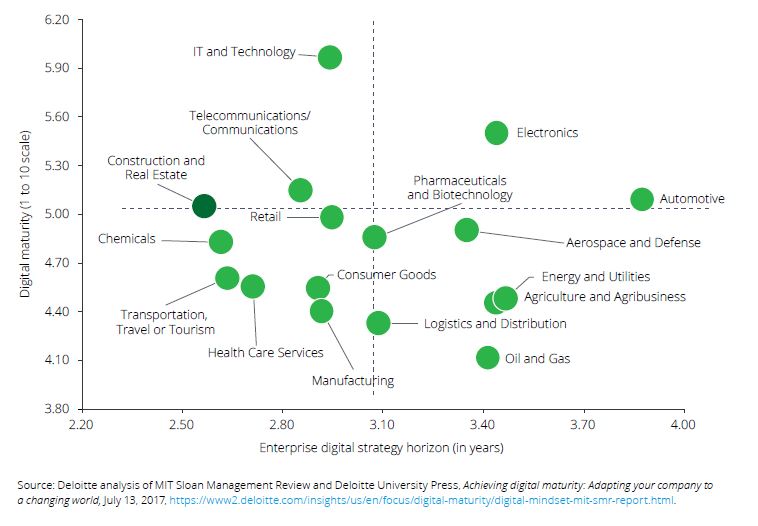It’s a topic of great concern to many in our industry – how do we attract the next generation of geospatial professionals?
It’s also a question that we’ve addressed in a column for GeoConnexion magazine based on the experiences of KOREC Director, Mark Poveda, who recently returned to his Dublin College with two colleagues to talk to final year students studying Geospatial/Surveying. However, college students are already engaged with our industry having actively chosen a relevant course and maybe we should be talking to students earlier.
A visit with value
For KOREC Operations Technical Support, Liam Hartley, the 450th Anniversary of his old school, Queen Elizabeth’s Grammar School, Horncastle (QEGS), set him thinking as to what sort of career information he’d have valued as a sixth former living in a rural part of the country just starting to consider future job prospects, apprenticeships, or degree courses.
As a QEGS alumni, he’d seen invites to assist students in CV preparation or interview techniques but felt that this could be the perfect opportunity to offer some time to share his thoughts on geospatial careers with an age group just starting to think about their own futures.
At the invitation of the school’s careers lead, Sarah Holmes, Liam was able to spend a couple of days at the school chatting about the geospatial industry to teachers and students alike.
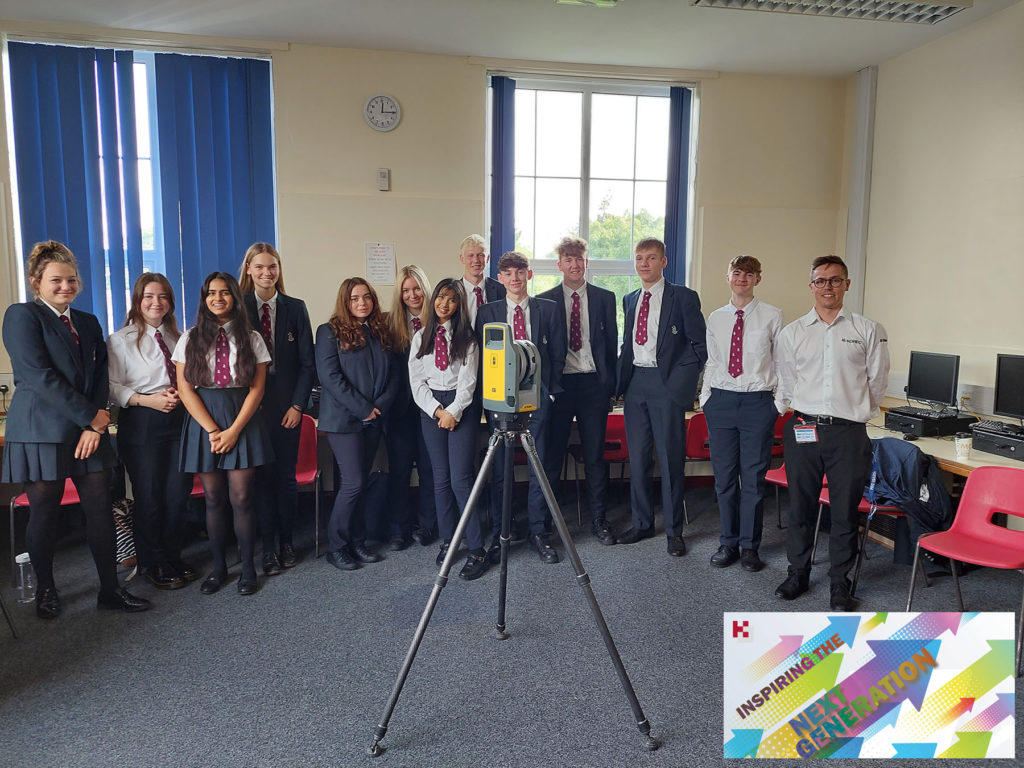
Great technology and engaging examples
Equipped with a Trimble X7 3D Laser Scanner and plenty of examples of what our industry has to offer, Liam reports that he spent a very rewarding 50 minute Development Class with the mixed group of students. Drawing on relevant examples such as 3D data (used in the gaming and film world) he outlined how F1 tracks are surveyed with Mobile Mapping, how sports events measure distance with total stations, how music festivals are set out with GPS mapping systems and how spatial data is everywhere and in everything we do, from using Google Maps to creating smart cities.
Liam feels that at least three quarters of the class seemed very engaged with four or five particularly responsive to the geospatial world. He reports, “I had a really rewarding two days at QEGS sharing my enthusiasm for an industry that has so much to offer as a career. Interestingly, very few of the students were familiar with the term ‘geospatial’ and of course, this highlights the problem we have in promoting a career where our key audience has very little understanding of what we do. If we’re to overcome this, then it’s vital that we are actively promoting our industry to this age group. Here at KOREC, we want to be a supplier that does just that and we’re perfectly positioned to do so from a unique perspective because we see everything that the industry has to offer technology wise. I very much want us to step forward and lead from the front.”
What next?
Liam used his two days at QEGS to plan for a future event for next year that he hopes can be rolled out to similar age groups in different schools. Watch this space!
To learn about KOREC’s Next Generation initiative (aiming to encourage a new generation to the geospatial industry) please contact marketing@korecgroup.com
Got a question? Want to find out more about the X7? Why not submit an inquiry with our friendly team?
Here at KOREC we love an analogy and this cycling one works a treat!
This year the Tour de France gave us a Wout van Aert as the winner of the prestigious stage 20 time trial in Paris. But he didn’t win the race. That honour was earned by the Slovenian Tadej Pogacar and it was he who finished the race wearing the yellow jersey.
Similarly, if your scanning operations depend on a speedy turnaround for your client, then you can be sure that the Trimble X7 has the features to get you over the finishing line first because the race doesn’t end without a fully registered point cloud that’s ready for the creation of 3D models, drawings etc.
Here are seven reasons why the X7 is unrivalled when it comes to delivering a timely, quality job:
- The Trimble X7 provides you with options to speed up your time on site. For example, thanks to a new firmware update (as recently shared by our laser scanning expert Melvin!), auto-calibration can now be switched off for shorter scans. This can save you 30 seconds per scan providing a 30% speed boost. Remember, you are in charge of the workflow, not the manufacturer, instrument or software. If you don’t need HDR photographs, you’d don’t have to have them, similarly for difficult surfaces or objects, with the Trimble X7 you can simply turn the high-sensitivity scanning mode on or off as required.
- It’s not all about the time the scanner is turning and collecting data. The X7’s auto-levelling feature ensures that you are ready to go as soon as you set the instrument down. The X7 has the IMU and dual axis compensator on all models, meaning data is always level to survey grade accuracy and does not require the same level of post-processing as those that don’t meet that same accuracy specification.
- The X7 doesn’t stop when you do! Infield registration is happening while you scan, full scan refinement, georeferencing, colourisation and export, in the same software on the same device, means that whilst you’re driving around between sites, the X7 is still working, registering the data so that it’s ready to send or transfer at the next stop.
- Or if you’re really pressed for time, you can use the wireless capabilities of the Trimble T10 Tablet and send the registered point cloud from the field.
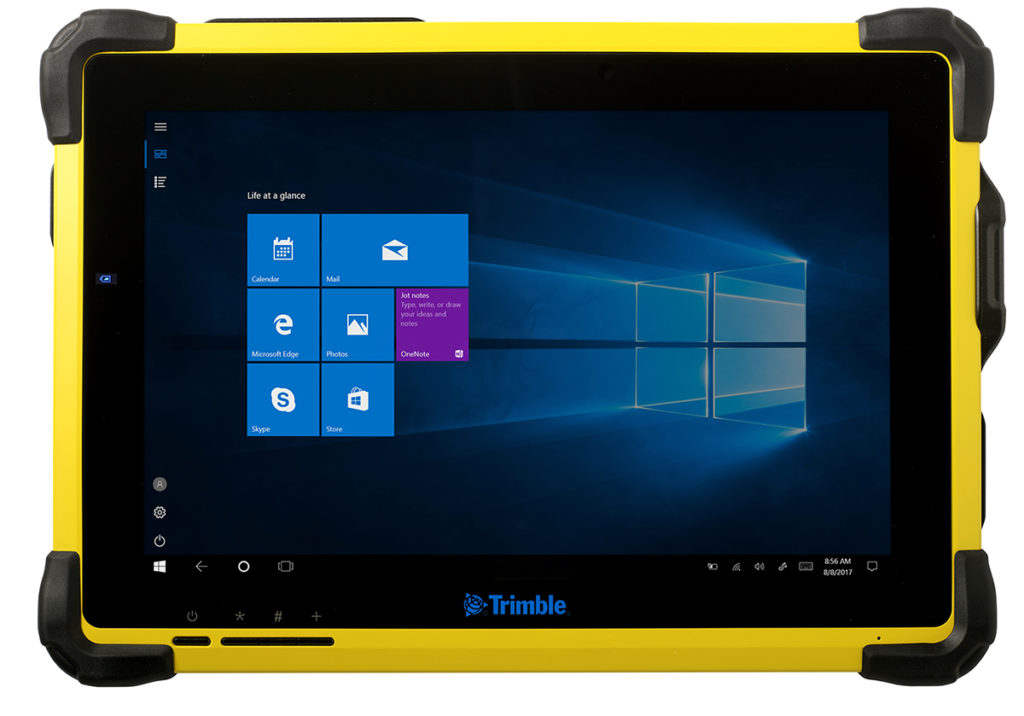
- The full onboard registration in the field also provides data surety – you can be sure that you’ve got everything whilst still on site so need for return visits for missing data.The unmeasured points view from each Station View assures you nothing has been missed whilst you’re still on site. This allows you to fill in any important areas before leaving, a great time saver if it’s something that may mean a return visit or incomplete data set if you had to wait to do this back in an office.
- It’s got a handle 😉
- Finally, the Trimble X7 has been engineered to capture 500,000 points per second ensuring a high quality point cloud cutting down on any issues that can come from capturing more data than you need, namely extremely large data sets that are unwieldy to handle, navigate, transfer and store to archive.
Got a question? Want to find out more about the X7? Why not submit an inquiry with our friendly team?
Call UK Sales: 0345 603 1214
Call Ireland Sales: 01 456 4702
For anything else, view our contact page.
Who needs low cost, on-demand, cm precision data collection?
“A cm accurate GNSS solution at the right price point.” Christopher Cooke of 3LM on Trimble Catalyst
We’ve just launched ‘A Grand Deal’ and it’s our offer of the summer! Mobile, on-demand data collection with centimetre-precision, our KOREC Capture data collection app and the KOREC Portal for review, analysis and reporting of data, all for under £1,000.
Key to this very grand offer and the exceptionally low-priced cm precision is Trimble Catalyst, our on-demand subscription based GNSS. Easy to set up and use, with a range of accuracy subscriptions available, the only hardware you need to purchase is the low-priced antenna.
But who can benefit from this offer? We took a look through our list of Catalyst users and the range is vast! Here are just some of the examples of KOREC customers who have selected Catalyst for their projects (full stories below):
V.T.O.L Media – establishing ground control points for aerial surveys
Operating out of Shropshire, V.T.O.L Media is a company that specialises in aerial photography, video and survey and in particular, construction monitoring. The company is owned by CAA Approved drone pilot, Neil Pepper, who has a mixed drone fleet and takes great pride in using only the latest in high-tech equipment.
The company has recently experienced an increase in demand for survey work with many clients requesting high accuracy aerial surveys. Aware that the use of ground control points would greatly improve the accuracy of any aerial surveys he undertook, and with many of the projects he was working on having little or no established GCP’s, he decided that the ability to establish his own would ensure total confidence in the accuracy of any aerial surveys he carried out.
Having researched various options for the precise positioning of chequer boards in wide open spaces or drains, road markings etc in urban areas, he found a perfect match for his requirements in Trimble Catalyst. Light, easy to use, compatible with his Android smartphone and by far the most cost-effective cm accurate system he could find, Neil says that he can place his GCP’s in under and hour and the cost of his Catalyst cm on-demand subscription is just £10!
3LM – a holistic approach to agriculture and the land
Yorkshire based 3LM is a member of the Savory Network, a global group that advocates, trains and supports land managers around the world to regenerate land through Holistic Management. 3LM specialises in the provision of educational and advisory services to agriculture and works with farmers who know that something needs to change, but are unsure what. Assisting this approach to change is the precise measurement and data capture of the four eco system processes fundamental to all life – water, minerals, solar energy and community dynamics.
3LM Company Director, Christopher Cooke has a strong background in both GNSS and water management and therefore turned to KOREC in his search for a cm accurate GNSS solution at the right price point. Finding the suggested Trimble Catalyst solution exceptionally easy to use and subscribe to, the company now has two systems comprising Trimble Catalyst, TDC600 logger and KOREC Capture field data capture software.
“The Trimble Catalyst system couldn’t be easier to use. It’s reliable, easy to subscribe to, and most importantly I know that our data is secure with zero chance of it being lost due to storage in both the cloud and on the TDC600. Having cm accuracy on demand allows us to accurately position any areas that we sample from and then navigate back to them at a later date for progress reporting. Additionally, the data management side of the system, developed by KOREC, really is world class.
“We have now achieved our aim of being paper free in the field and have particularly enjoyed how this technology has captured the imagination of the younger generation of farmers and land managers that we work with.”

TP Knotweed – rapid response identification and removal of knotweed
Aggressive, destructive, relentless, Japanese Knotweed is the most invasive plant in the UK and remains a major problem for the construction industry. One company specialising in its removal is Oxfordshire based TP Knotweed, a company that is prepared to invest in technology in order to increase efficiency, whether that be CRM, van trackers or new apps, or in this case Trimble Catalyst.
When TP Knotweed takes on a project, it’s vital that they have very accurate measurements as to the area of an infected site if they are to prepare an exact quote for their clients, along with a map of the project including the position of any boundaries, stockpiles trees etc.
For smaller sites, their solution was a Trimble Catalyst subscription for cm accuracy along with KOREC Capture software which could run on one of their existing Android smartphones or tablets.
TP Knotweed found the Catalyst system quick to set up and easy to use making it ideal for fast turnarounds on these sites. The company also reports that the systems are in use every day and that the quality and quantity of information they are collecting is proving vital for another of the company’s aims, to build a UK wide shareable database of knotweed contamination.

A14 Integrated Delivery Team – fast one-off positions and augmented reality in the field
The £1.5bn A14 Cambridge to Huntingdon improvement scheme was one of Highways England’s largest recent projects and the 34km site provided the contractors involved with a perfect testing ground on which to share new ideas and balance tried and tested technologies alongside new ways of working.
For Skanska’s Mark Lawton, Chief Engineering Surveyor, A14 Integrated Deliver Team, Trimble Catalyst provided two useful areas of investigation for potential use on future projects:
1. Contractors on the A14 scheme often required accurate positioning in ‘one off’ situations. For example, those carrying out borehole testing or soil sampling needed accurate positions either to map a new point or navigate back to a previously recorded one. However, it would not be cost-effective to send a fully trained engineer with survey grade GNSS to carry out these tasks. An obvious alternative was Trimble Catalyst, in this case using its on-demand subscription model with KOREC Capture data collection software running on the contractor’s smartphone. KOREC Capture could offer the contractors fully customisable lists, drop down boxes, mandatory fields etc which again would bring consistency of data, to the attribute information collected as well as cm positioning.
2. Mark also successfully trialled Trimble SiteVision, a system that fuses cutting-edge augmented reality technology with Trimble Catalyst centimetre-precision GPS. The end result is a system that allows you to take your models, drawings and data off the screen and onto your site. Key application areas included utility records, design information, future information and 3D models. In particular, Mark mentioned that on the A14, following the capture of hundreds of km of cable, they needed to know exactly where that cable was for a Permit to Dig. Having the information available visually through SiteVision was hugely helpful in determining where they could excavate.
Additionally, he says that SiteVision provides an easy to understand visual explanation to third parties, such as householders, as to why they are digging in a certain place.
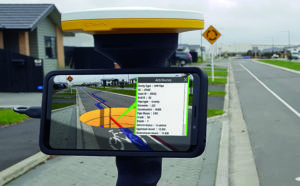
What’s Next?
Take a look at the Trimble Catalyst product page
Watch the official Trimble Catalyst video on our YouTube channel
Make sure you follow KOREC Mapping for all the latest news, info and events
A recent report by Deloitte on the development of the construction and engineering industry until 2050 identified the key trends set to shape the industry, the priorities and challenges that construction professionals should be aware of, and the technologies and solutions that are on hand to help us meet these challenges.
The report defines Connected Construction as an ecosystem – a connected network of capabilities such as collaboration, real-time project visibility, worker safety and data that promotes the most effective, efficient, productive and safe delivery of projects.
As a key equipment supplier to the sector, in both Ireland and the UK, KOREC believe that it is vital for our customers to be aware of these findings, and to present solutions for how we can tackle the challenges, head-on.
We’ve reviewed the report and pulled out what we believe to be the key findings, which we’ll present over 3 sections – the challenges, the key technologies involved, and finally, the opportunities.
The Opportunities
We’ve identified four broad areas of opportunity that focus around; processes, data, people and future-proofing. We believe there are huge gains to be made by forward-thinking firms that take the time now to investigate the technologies that are available to them.
Streamline your Processes
A digital record of project plans (literal 2D & 3D plans, as well as scheduling) brings a wealth of information to your fingertips. Construction software such as Trimble FieldLink create a fully-connected flow of information both from and to the office allows you to avoid guesswork, make informed decisions on site, and cut down on the risk of costly errors. Other tools such as Bluetooth beacons, managed WiFi and on-ground sensors can track equipment performance and maintenance – equipping you with the latest information you need in order to make informed decisions.
Leverage your data’s full potential
Office-designed BIM models contain a huge amount of valuable information and data about a project – why lose a huge chunk of that value when bringing the design onto site? With connected, digital and paperless solutions, you are ensuring that the data you are working to on site, is identical to the data prepared in the office. What’s more, with tools such as the XR10 it’s simple to mark-up changes on site – which can then immediately be updated on the BIM. A virtuous cycle of powerful information, between the office and the build site.
Upskill your Staff
Autonomous or semi-autonomous technologies, such as robotic total stations, drones, and even robots, can take the slack when it comes to hazardous, repetitive or unskilled tasks. For example, a robotic total station requires only one semi-skilled operator, not two – immediately reducing personnel on site – or freeing them up for other tasks. Looking further afield, robots (or co-bots as they’ve been termed) such as Spot the Dog can be programmed by their human colleague to undertake manual tasks – even working throughout the night and at weekends to drastically cut programme schedules.
Future-proof your Business
The construction and engineering sector is at somewhat of a crossroads – huge global demand, a wealth of interconnected technologies available, stubbornly-low profit margins, growing concerns around environmental sustainability, and a well-publicised skills shortage.
In order to attract a new generation of educated, informed and skilled workers to the profession, the sector must engage with currently-available connected technologies, which will in turn drive down costs, and drive demand for new solutions.
At a business level, those organisations (such as Nugent Manufacturing) that take a long-term, joined-up and open-minded approach are more likely to experience the gains in productivity, efficiency, safety and profit margins that those who operate in a business-as-usual manner. And it is those digital-ready organisations that are best placed to attract the top talent to ensure their future growth.
Key Technologies
The report identified 6 key technologies, some of which are already beginning to make major inroads into the efficiency and productivity of our industry;
1.Robotics
Dull, laborious and repetitive tasks are better performed by a robotic assistant (see Spot the dog from Trimble & Boston Dynamics!), freeing up their human colleagues for safer, higher-skilled tasks
2. Automation
The growth of AI could lead to the rise of intelligent buildings – structures that learn how to run and operate themselves – saving energy, money and resources
3. 3D-printing
Having accurate, digital design information (as provided by the Trimble X7 3D scanner) allows for complete 3D-printed assets (including the world’s first inhabited 3D printed house)
4. Autonomous Vehicles
High-accuracy data of construction sites paves the way for robotic ‘workers’ to work around the clock – leading to huge reductions in project delivery timescales
5. Unmanned Aerial Vehicles
Rapidly becoming a fixture of construction sites across the country, UAVs enable the rapid and contact-free survey of large and difficult to access areas – ideal for regular project progression updates and site inspection.
6. Virtual, Augmented and Mixed Reality
Visualise completed projects before ground has even been broken – augmented reality solutions such as SiteVision allow for unbuilt, underground or unseen features to be viewed in-situ, whilst wearable mixed-reality such as the XR10 allow contractors (as well as clients) to undertake walkthroughs of complex sites.

There is a link to download the full 16-page report at the bottom of the page.
The Challenges facing our industry
- Only ¼ of the global infrastructure we’ll need by 2050 exists today. Every single day, over 200,000 people move into the world’s urban centres.
- The Construction industry is only looking 2.5 years ahead when it comes to digital strategy – ranking bottom out of 17 industries for forward-thinking and planning.

- Profitability and margins are stubbornly low – earnings averaging just 5% of sales. Not only does this affect the bottom line, it also deters higher-skilled graduates from entering the profession
- Engineering and construction firms experience an average of 82-days outstanding sales (i.e. unpaid invoices) – longer than all other industries. Again, this affects cash-flow and stunts the ability of the business to invest.
Find Out More…
Case Study – how one KOREC customer are punching well above their weight by investing in a complete field-to-finish digital construction workflow
- Download the complete Deloitte report
- Check out our complete range of laser scanners, robotic total stations, mixed reality and office-to-site software
- Speak to us about our range of digital construction tools
Thanks to all the industry publications that continue to showcase KOREC supplied technology in our articles, columns and case studies. Here’s a round-up of where we’ve been in the last couple of months:

GeoConnexion UK (May/June)
The only way is up! Mark Poveda’s column is a must read for anyone who’s interested in the latest technology, opinion and developments in our industry. In his most recent piece, he takes a closer look at why the drone business is burgeoning and consequently, with so many choices on the market and new developments, why it’s never been a better time to invest.
Read his column here.
In the same, issue there’s also a great piece by Jodie Hartnell featuring the Trimble X7 which asks ‘Are laser scanners evolving into cobots?’
Civil Engineering Surveyor (April)
You may have noticed that we’ve just launched KOREC Mapping, in a move to consolidate and expand the KOREC offering of field to office data collection and handling solutions available across the UK and Ireland. It therefore seemed the perfect time for our KOREC Mapping Business Area Manager, Richard Gauchwin, to highlight a very important aspect of the digital data capture industry, namely ‘How technology can make a safer place for workers in the field.’
Read the full piece here.
Civil Engineering Surveyor (May)
For the May issue of CES, we revisited our popular case study format with a look at automated tunnel monitoring through a remote set up. Entitled ‘Whilst you were sleeping’ all the information for this piece was supplied by Mark Anderson, Director of Academy Geomatics. It’s proved a popular story with Trimble featuring it on their website and it will also appear in GIS Resources in June as part of their infrastructure/geomatics feature.
Read the full piece here.
Virtual reality, 3D Laser scanning, robotics, AI, reality data capture, data analytics….today’s careers in the geospatial industry offer numerous possibilities and are a perfect fit for the tech savvy, early adopters of Generation Z who have grown up immersed in technology.
Fuelled by technological developments, the collection and processing of spatial data is now a far cry from the days of just muddy boots and making maps and reflecting these advances is the Technological University Dublin which has recently adapted its BSC in Geospatial Surveying. Changes include a modular approach, updated content and opportunities to combine working with a relevant company whilst completing a degree.
Hands-on with technology
A vital part of any course is for students to be fully aware of developments within the industry. KOREC Ireland’s Mark Poveda, Niall Hand and Fran Mullally (geomatics graduates of the university), along with KOREC colleague Kevin Kinahan, were therefore delighted to have the opportunity to present some new ideas to the University’s 1st and 2nd year students. This was achieved through an on-line presentation and then a day of socially distanced hands-on experience with some of the world’s most advanced Trimble survey technology.
Bringing with them a selection of Trimble instruments including Trimble’s SiteVision Augmented Reality system, the X7 3D Laser Scanner and an R12i GNSS, Mark, Fran and Kevin also had KOREC sponsored hoodies for all the students involved, which was extremely fortunate given the rainy conditions!

Great weather for a new KOREC sponsored hoody!
Whilst the students enjoyed the hands-on session, KOREC’s Mark Poveda hopes that the on-line presentation provided a useful source of information on how far reaching and exciting the geospatial industry has become. Particularly well received was the ‘Spot the dog’ Trimble robot video which can be viewed here.
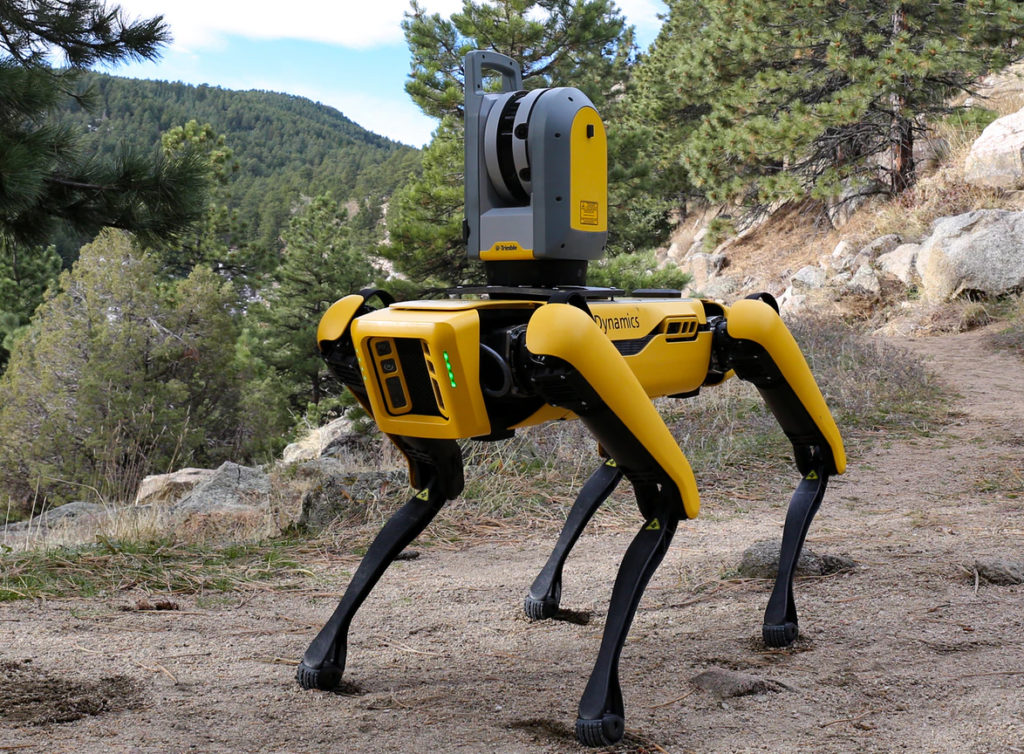
Spot the Dog
“The demonstration day was a great way to finish off my college experience in the BSc of Geographic Science. The Korec team talked us through the operating system of the latest Trimble survey equipment and offered us the opportunity to try out the instruments ourselves. The weather behaved in typical Irish fashion and rain showers were frequent. I was especially impressed with the quality of deliverables produced by the Trimble X7 Laser Scanner and accompanying touch screen under these conditions. The seamless workflow of this machine really highlighted the modern advances in technology enabling us, as surveyors of the future, to carry out surveys to the highest standard regardless of what the Irish climate throws at us. Advances such as these in technology makes me excited for my future career as a surveyor and I can only wait in eager anticipation of what else Trimble will release onto the market in the coming years. “
Rose Pearson, final year student, TU Dublin
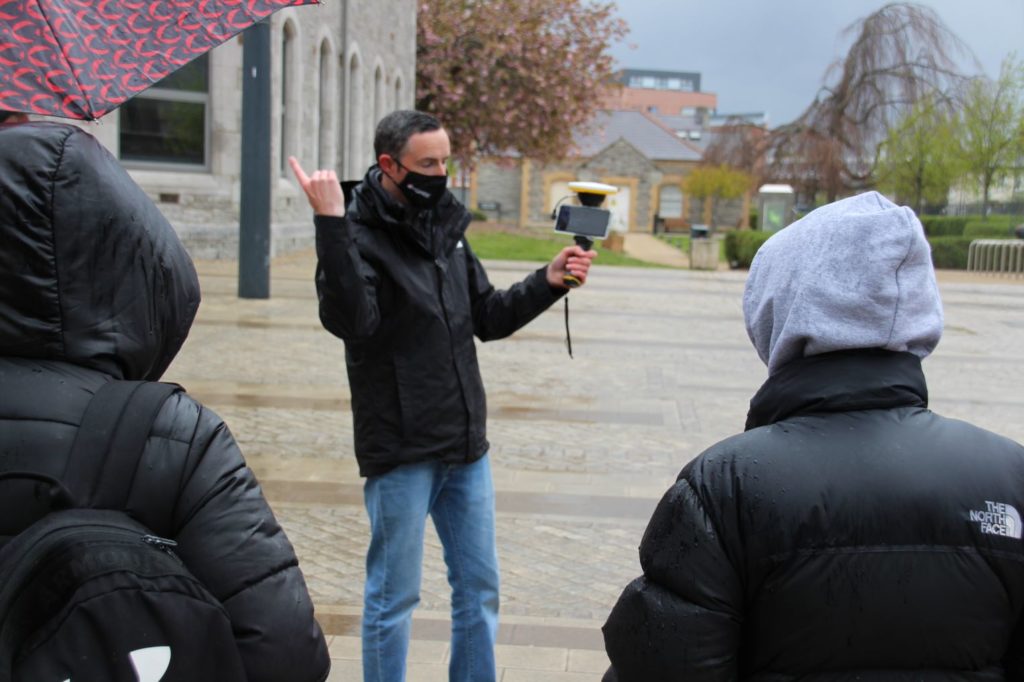
Augmented reality with Trimble SiteVision
“…..the technology demonstrated was very sleek, it was extremely easy to use and makes quick work of any of the tasks given to them. The scanning technology particularly was great, especially being able to view scans right after taking them.”
“The day spent with members of KOREC was extremely insightful and enjoyable. The demonstrations they showed us offered an exciting look into the advancements of this industry and their equipment as well as the broadness of its opportunities.”
1st/2nd year students (TU Dublin)
Our thanks to Dr Audrey Martin, Senior Lecturer, Chair BSc Geographic Science (TU Dublin) and of course to the students who attended and were kind enough to provide some great feedback.
It was only a few weeks ago that we caught up with Sky Revolutions Company Director, Ben Gorham when Sky Revolutions became the first KOREC customer to invest in the newly launched senseFly eBee GEO. This time we’re back with Ben talking about a particularly successful week the company’s had with the Trimble X7.
Whilst picking up the new eBee from the KOREC Huntingdon office, members of the Sky Revolutions team took the time to take a closer look at a Trimble X7 3D Laser Scanner that was on site that day and immediately saw how it could contribute across the business and in particular, to an upcoming measured building survey project.
With over 20 years’ experience in construction surveying, Sky Revolutions undertakes a wide range of work and until recently carried out its measured building surveys using the traditional method of a Trimble S7 Robotic Total Station. However, already familiar with 3D laser scanning technology, they were keen to see what the X7 could deliver on the planned job of 25 measured building surveys on structures ranging in size from as small as a shed sized sports pavilion to as large as an office block with everything in between.
When we caught up with Ben, the Sky Revolutions team had successfully completed eighteen of the scans in just four days and expected to be finished in five. Ben explained, “Our aim is to deliver projects promptly and to supply our clients with data of the highest quality. The X7 has been exemplary in helping us achieve those aims. The scan speed alone has really assisted on this project as did the smart auto-calibration. We’ve had laser scanners before but the X7 is a step ahead. The argument for not buying one doesn’t really exist!”
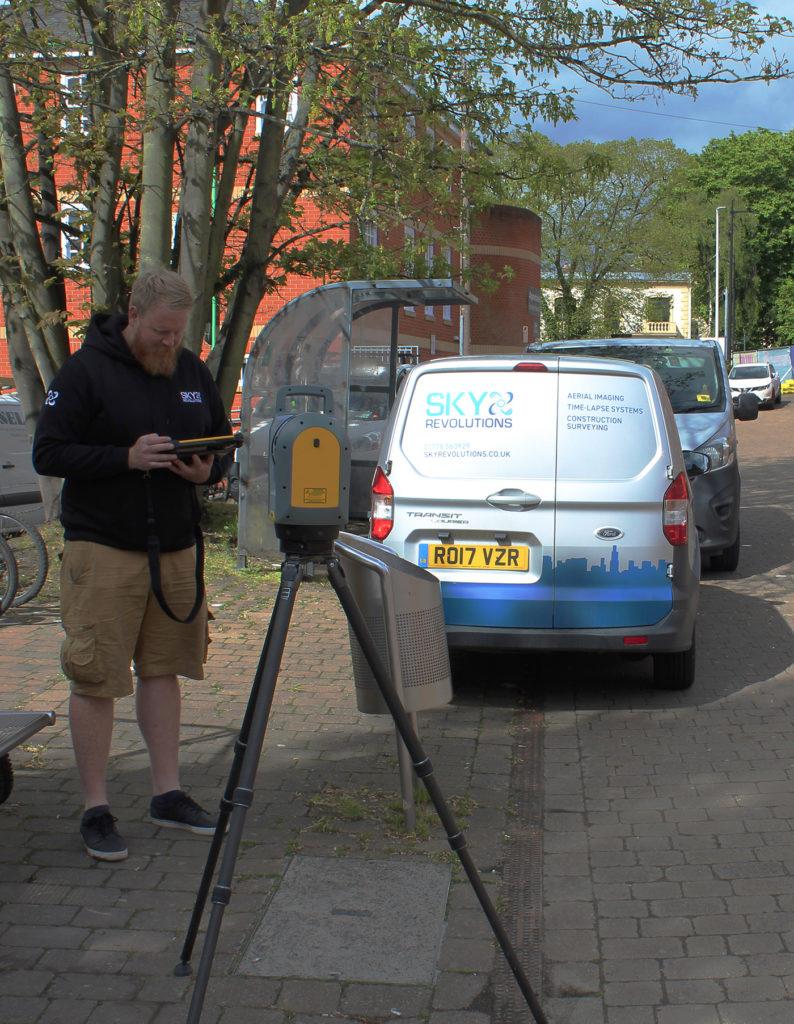
Sky Revolutions surveyor Dave Gaffney puts the Trimble X7 through its paces
Peterborough based KOREC customer, Sky Revolutions, is a company that certainly knows its way around the aerial mapping sector and as one of the very earliest UK surveying businesses to realise the benefits of drone surveying, it also has an extensive knowledge of the technology involved.
That’s why we are delighted to announce that it has become the first company in the UK to take delivery of senseFly’s newly released fixed wing drone, the eBee GEO.
Designed to deliver senseFly’s superior build quality and extensive functionality at a fraction of the price of similar drones, the eBee GEO is all about user ROI and is especially suitable for the many varied projects that Sky Revolutions undertake.
For company Director, Ben Gorham, the eBee GEO is a perfect choice for Sky Revolutions which has seen an upsurge in demand for aerial survey work following the restrictions imposed by COVID.
Ben rates the eBee GEO for four particular reasons:
- The RTK option allows the Sky Revolutions team to achieve the 2.5cm accuracy demanded by many of their projects
- With a battery life of 45 minutes, the eBee GEO is a producitive choice for the increasing number of larger jobs the company is working on
- The S.O.D.A. camera provides impressive accuracy at 400ft
- Some of Sky Revolutions’ jobs, such as a recent coastal survey in Suffolk, involve several miles of walking. The eBee GEO has a take-off weight of just 1.3kg and is easy to transport in a backback.
Ben concludes, “There’s no doubt that the eBee GEO makes good sense for us financially and with its impressive accuracy it is the perfect addition to our fixed wing offering. KOREC’s been great at meeting our requirements and understands that we are a company valued by our customers for our specialist surveying skills and consequently have high expectations of every investment we make.”
Sky Revolutions has just successfully completed a first mission with the eBee GEO carrying out a coastal survey on behalf of Suffolk County Council.
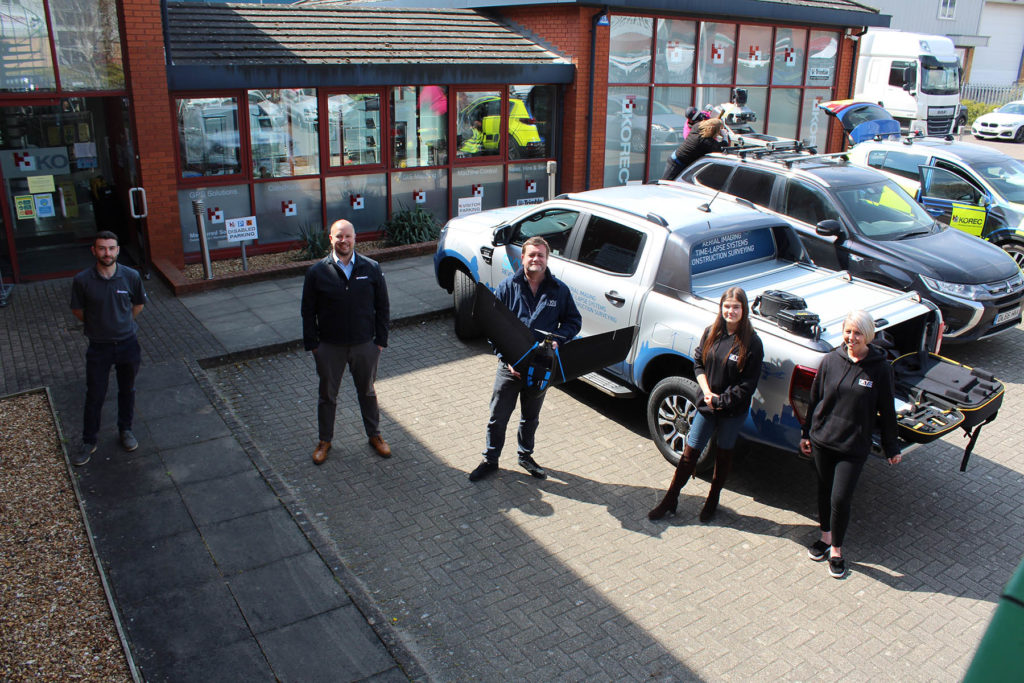
Sky Revolutions pick up their new eBee GEO from KOREC’s Huntingdon base. From left to right, James Tindall (KOREC Geospatial Technical Support), Lloyd Wilkinson (KOREC Geospatial Sales Consultant), Ben Gorham (Director, Sky Revolutions), Madison Gorham (Apprentice, Sky Revolutions), Anna Carter (Office Manager, Sky Revolutions)

Madison Gorham (Apprentice, Sky Revolutions) and Anna Carter (Office Manager, Sky Revolutions)
Definitely not when it comes to examining why the Trimble X7 3D Laser Scanner lends itself to the pressures of crime and collision scene investigation!
We round up the top ten reasons why the X7 delivers on key requirements.

Over the years, KOREC has enjoyed a long and informative relationship with the UK’s police forces supplying a range of survey instruments from integrated GNSS and Total Station Systems to more recently, 3D Laser Scanning technology including the groundbreaking Trimble SX10 Laser Scanning Total Station.
Crime scene and collision evidence gathering is a discipline that brings its own set of challenges. The pressure to work quickly and capture every detail of a scene, often with no chance to revisit the site later, means that the emergency services need to have 100% confidence in the reliability of their data. They need to be able to gather that information quickly and it needs to be accurate, all encompassing and sufficiently robust to stand up in a court of law. Consequently, we’ve seen a shift towards 3D Laser Scanning as the best methodology for capturing a scene as quickly and completely as possible. Additionally, this can often be done from the side of a site reducing the chances of contaminating evidence.
The latest Trimble X7 3D Laser Scanner lends itself to the unique set of challenges faced by the police in a number of ways:
- Ease of use – the learning curve for the X7 is the shortest of any scanner we’ve ever seen with our training department estimating that even a non-surveyor can be efficient in data collection within hours. This gives it a far wider range of use. Thanks to its intuitive Perspective software running on a tablet, crime and collision scene investigators can reliably collect scan data even if they have not used the instrument for several weeks.
- Fit in with your existing workflow – export formats supported include Trimble and non-Trimble software through the instrument’s new Trimble Perspective software. For example, the open .E57 format for easy importing of data straight into Leica’s Cyclone software.
- Verification of information on site – the X7’s automatic on-site registration means that officers can check that all the information they need has been collected. Often there is no chance to revisit a scene, so this feature is vital for ensuring a full and detailed survey has been completed before leaving the site.
- Survey completed and sent from the site – with registration carried out on site, the finished scan data can be sent from the field for immediate analysis. This ensures a smooth flow of information in an environment where shift work and office processing time can delay the final deliverable by days.
- Fast set up and use – the X7 can be up and running in minutes thanks to the quick release mechanism and automated survey grade self-levelling – just put the scanner down and it’s ready to go.
- Night-time benefits with easy moving and set up around the site – an IMU has been included in the X7 which calculates the new station orientation and will import new data with this orientation already applied. The registration process which follows is then much faster due to the scan already having the correct orientation- just pick it up, hold it as you wish, walk where you want and put it down. This also makes it great for night-time working because unlike other manufacturer’s scanners it is not subject to the dark/low-light condition caveats that optically based solutions are.
- ROI – auto calibration brings reliability, cost-savings and no downtime – not only is the X7 priced competitively, but users are calculating that the auto-calibration feature alone can save in excess of £3k – £4k a year because unlike other manufacturer’s scanners, the X7 does not need to be sent abroad for this process. Instead it’s done automatically, every time it’s used, with the option of a printable certificate.
- The calibration of some instruments can take up to 2-3 months requiring the hire of a replacement instrument. The X7 eliminates the need for this.
- Rain never stops play – Trimble instruments have a proven record in the rain and with its IP55 rating, the X7 is no exception.
- Highly portable – the X7 weighs just 5.8kg and can be carried easily in a backpack.
- Excellent data quality – fast data collection plus the option of a high sensitivity mode for scanning dark vehicles etc.
- Images and annotations – Trimble Perspective software on a tablet drives the X7 and allows users to annotate, add images, tags, notes etc.
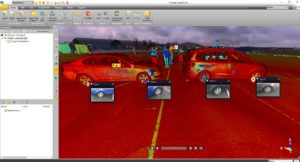
Scan data from the Trimble X7
For further information on the Trimble X7:
Call UK Sales: 0345 603 1214
Call Ireland Sales: 01 456 4702
For anything else, view our contact page.
KOREC is delighted to announce that following extensive behind the scenes work demonstrating our ongoing commitment to support the Esri user community, we have been recognised officially as an Esri Silver Tier Business Partner.

This new status will further strengthen the KOREC/Esri relationship allowing KOREC to offer Esri’s ArcGIS software as part of its mapping portfolio to new and existing KOREC customers.
Silver Tier status will also provide Esri UK’s customers with access to KOREC’s in-house software development team and its specialist knowledge on the integration of Trimble GNSS into Esri mobile data capture software.
Potential development for Esri clients will include everything from small tweaks to bespoke workflows based on the ArcGIS system, bringing all the power of their existing software but with customisation options for specific data capture workflows.
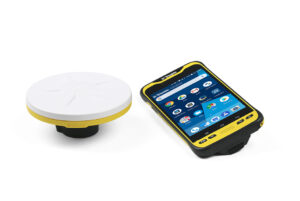
The Trimble Catalyst solution with a TDC600
The KOREC mapping team will also be available to assist Esri users with the integration of GNSS into their workflows with up to centimetre positional accuracy. Esri users will now have access to the most cost-effective method possible for cm accuracy by means of Trimble’s subscription based, low cost Catalyst solution.
To discuss all development requirements please contact KOREC Business Area Manager – Mapping & GIS, Richard Gauchwin on 07786 118436 or at richard.gauchwin@korecgroup.com
Or visit www.korecgroup.com/mapping



